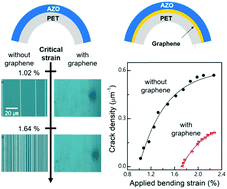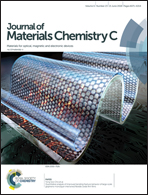Quantitative analysis of improved bending fracture behavior of large-scale graphene monolayer-intervened flexible oxide thin films†
Abstract
Graphene has been recognized to be potentially useful in creating higher mechanical integrity of electronic components due to its intrinsically superior mechanical properties. Here, we introduce the enhanced bending fracture resistance of flexible inorganic thin films by incorporating a large-scale graphene monolayer, using a typical example of transparent conducting oxide (TCO) materials, i.e., Al-doped ZnO (AZO) thin films. The bending fracture behavior has not been available thus far due to the inefficient coverage of the graphene layer, and also particularly on the basis of the quantitative analysis of fracture parameters. A graphene monolayer of the ∼1 cm × 1 cm scale was successfully transferred onto a flexible polyethylene terephthalate (PET) substrate prior to sputter-deposition of thin films with variable film thicknesses ranging from 50 nm to 200 nm. The highlights of the substantial improvements are the crack-initiating strain of 1.64% and the fracture energy of 364.2 J m−2, which were obtained for the graphene-intervened 200 nm-thick AZO films. These values correspond to respective improvements of ∼61% and ∼272% compared to the reference sample without graphene. Other parameters including the film strength and fracture toughness also support the enhanced bending fracture resistance caused by the graphene-modification.

- This article is part of the themed collection: 2018 Journal of Materials Chemistry C HOT Papers


 Please wait while we load your content...
Please wait while we load your content...